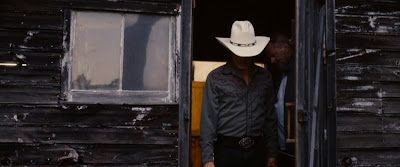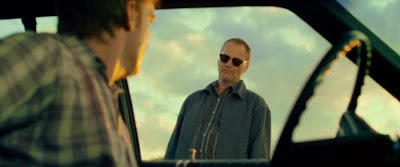Some of the grisliest of the horror stories from the old E. C. Comics were published in their crime titles. The covers that got them in the most trouble with the Kefauver hearings were for Crime Suspense Stories and Shock Suspense Stories (though, in all fairness, Tales from the Crypt et al. weren't far behind them in terms of horribleness). When Robert Bloch bolted from the horror genre in the 1950s, it was to crime novels that he went, one of which was an unassuming potboiler named Psycho. I mention this because Cold in July (2014, directed by Jim Mickle) is one of those movies that straddles crime and horror. It's got a mean streak. Joe R. Lansdale, upon whose novel the movie is based, has been writing crime horror hybrids for decades now, and this one is salted a bit with the western. It's a man's gotta do what a man's gotta do sort of film.
The plot here finds frame-shop owner Richard Dane shooting a man who has broken into his home. The man's father, Russell, is recently released from prison and begins to menace Dane to the point that he asks for police protection. When he makes his move, the police come down on him hard. When Dane goes to fill out the paperwork at the station house, though, he sees a wanted poster for the man he supposedly shot and discovers that it's not the same person. More, the police haul Russell out of the jail in the dead of night, drug him, and leave him on the railroad tracks. Dane drags Russell to safety and the pair of them begin to investigate what's really going on with Russell's son. Russell's friend, a private detective named Jim Bob, tracks him to the witness protection program, but manages to ferret out his location anyway. What Russell's son is really up to is a horror show. Dane could just walk away from it, but it gnaws at him. The horror is simply too great for him to simply walk away and do nothing...
On a basic level, this movie is a study of masculinity and fatherhood. Both of its principle protagonists are fathers and it's their sons that provide them with their initial conflict. What kind of sons they raise provides them with a unifying motive. It's a film that probes violence as an essential component of masculinity, while inverting the way it codes this. Richard Dane, played in the film by Michael C. Hall, is a variant of the character Dustin Hoffman plays in Straw Dogs. He's essentially a coward who is provoked into violence by circumstances beyond his control. By contrast, Russell is raw aggression and menace from the get go. In a film that admires violence, Russell would be the hero and Dane would be the weak link. In this film, which does not admire violence even as it paints the walls red, Dane is the hero and Russell's sense of wounded manhood drives him to heinous acts. At the end of Straw Dogs, Hoffman's character lets a little smile flash across his face. He enjoyed the violence he perpetrated. In this film, Dane is revolted by it. He often looks as if he is going to puke in its aftermath. Dane isn't particularly good at it, either. Both of the men he kills in the film are killed by accident.
This is the kind of buddy movie that John Carpenter used to make. The movie is aware of its influences: when it quotes from Carpenter, it leaves a notation. The best of these quotations is the scene where Russell has broken into Dane's house and is standing over his son's bed. He's illuminated by a flash of lightning and for a brief instant, he's transformed into something from the outer dark, into The Shape from Halloween perhaps. The boogeyman. The film is set in 1989, and apropos of its time frame, it indulges in a Carpenter-ish synth score. Perhaps as a nod to the kind of film this aspires to be, a video store figures prominently in the film's plot. This is certainly the kind of hybrid thriller that used to find a cinematic half-life on the back shelves of video stores.
That said, its roots remain literary. Lansdale's book is largely preserved in this film, but it does lack a bit in the flavor of Lansdale's prose. That may be something that's beyond the ability of film, but I don't know. It's not like people haven't captured the flavor of other distinctive prose stylists before. Chandler, for instance, or Ray Bradbury. For want of a better word, this film is colder than what you find in Lansdale's novel, perhaps because it substitutes a schematic sense of style for the writer's local color and verbal humor. Mind you, it has his appetite for the grotesque. The scene near the end when Dane is struggling for a gun and it goes off, painting the light fixtures red, is pure Lansdale, as is the sick humor in the titling of a snuff film that figures in the plot. This is a weird thread of criticism for me to pursue, actually, because Lansdale's prose is partly derived from an immersion in cinema culture. I don't know how else to describe it, though.
The closest this comes to Lansdale's prose is in the portrayal of Don' Johnson's Jim Bob, who is almost a cartoon. The actor relishes the outlandishness of the role and whenever he's on screen, the film has a kind of manic glee behind it. Oh, don't get me wrong: Michael C. Hall is terrific in the lead, a character who is dramatically different from either Dexter Morgan or David Fisher. Hall is one of those chameleonic actors who seems to fade into his characters. Sam Shepherd for his part oozes menace as Russell before settling into a groove as a man whose very manhood is offended by what his son has become. For that matter, Jim Mickle continues to evolve into one of the few solid genre guys still working, one mostly untouched by self-conscious post-modern reflexivity. I'm not going to complain about the feast laid out by this film even if it tastes different than what I was expecting.
Current Challenge tally:
Total Viewings: 5
First Time Viewings: 4
Around the Web:
Jose at Riding the Nightmare is keeping pace with The Challenge. He caps his week with May, which is one of your humble bloginatrix's favorite movies.
Blog bestie Anna at Bemused and Non-plussed summarizes their week with a reckoning of several films along the arbitrary "Ashmore Scale," due in part to the large amount of Shawn and Aaron Ashmore in their selections out of the gate. Some hum-dinger's in the mix, including a delicioius Jessica Harper double feature.
Lady Terminator Erika rolls on with a load of Cronenberg and monsters in Nightbreed and postmortem shenanigens in The Undertaker and His Pals.
Eric at Expelled Grey Matter takes on Perkins 14 from the inconsistent After Dark series, and The Dentist.
Scott at Blasphemous Tomes powers through the first third of the challenge with Karloff in The Black Room and takes a beating from the recent Spanish film, Kidnapped.
Tim at The Other Side cozies up with a double shot of sequels to Count Yorga, Vampire, one official, one not.
Kevin at For It Is Man's Number looks at The Boogeyman 2, Sugar Hill, and Witching and Bitching.

I'm trying out Patreon as a means of funding my blogs. They don't have a widget yet, so this link will just have to do. If you like my writing and art and if you'd like to support Krell Laboratories and Christianne's Art and Comics, please come on over and pledge. Thanks.




















No comments:
Post a Comment